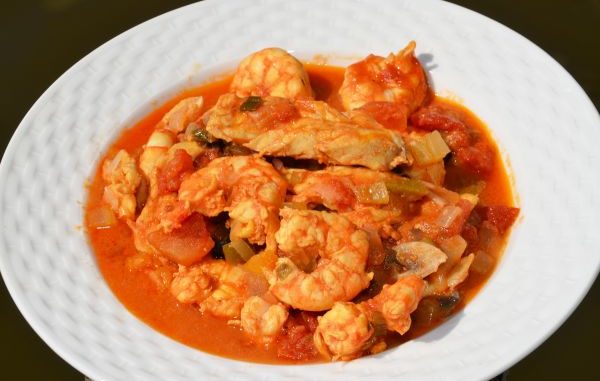
Retired G.I. police chief loves to cook
Euris “Doobie” Dubois retired last month as chief of police for the Town of Grand Isle. While he was the fishing resort’s chief law enforcement officer, he was just as well known for his cooking.
“I’ve been cooking on Grand Isle almost 30 years,” Euris said. “It started with the Caminada Redfish Rodeo. They wanted a redfish courtbouillon; I cooked for 250 people and put 100 pounds of redfish fillets in it.
“Two years ago, I started cooking more bouillabaisses. Courtbouillons take two days to make. You have to make a roux. A bouillabaisse is cooked in butter. Both are red in color and use mainly the same ingredients, but a bouillabaisse needs less time to make.”
Originally from “up the bayou” — Cut Off to be exact — Dubois moved to Grand Isle in 1978 to marry Connie Pitre, whose family owned Telstar Seafood, a shrimp-buying dock and were shrimpers themselves.
He kind of naturally drifted into the seafood industry and shrimped for 27 years before giving it up.
“Being Chief of Police was a full-time job,” Dubois explained.
He started cooking early, about age 15. The last time we cooked with him, he talked about his family’s cooking heritage.
“I watched my momma cook. I watched my parrain (Cajun French for “godfather”) cook,” Dubois said. “When my relatives cooked, it was like a party. We would eat a variety of things: wild game — rabbits, deer and ducks — bouillabaisses, redfish courtbouillon, a boucherie three times a year, spaghettis, chicken or seafood gumbos on Sundays, always with potato salad, boiled shrimp or crabs.
“There were always, always people there. We never went anywhere. We would just get together.”
It was a family affair.
“My brother Ray cooks the best white beans,” Dubois said. “He puts a cup of cooking oil in 2 pounds of beans. When you eat his beans, you will never want anyone else’s. He makes good hog head cheese, too. It is out of this world.
“My momma (Corrine) made a gumbo that was hard to beat. Dad (Louis) liked to pot-fry rabbits. He cooked turtle soup and turtle sauce piquant. Oh Lord! He loved that. He would catch his own turtles.
“Another dish that we don’t make any more is garfish boulettes. We made them with seasonings — no potatoes — and fried them. We would catch them in piano wire loops on jugs.
“My daddy always had a big garden. So did my mother’s dad, George Delatte.
“Food was No. 1 with us. As long as I can remember, we would get together and cook — have a good time. Food means a close relationship with my family.”
Fish and Shrimp Bouillabaisse
“I learned to make bouillabaisses from my parrain, Sam Delatte from Cut Off,” Euris “Doobie” Dubois said. “Bouillabaisses are a Bayou Lafourche specialty. Now they are my specialty.”
The list of events for which he has cooked bouillabaisses is impressive and includes law enforcement groups, political pow-wows, fishing rodeo clubs and an endless number of community functions.
Louisiana bouillabaisses are quite different from those in Marseille, France, where the dish originated. French bouillabaisses are made with at least three and sometimes seven kinds of fish. Most often, bony bottomfish and eels are used. Shellfish are often not used, and when they are they are secondary to the fish.
Bayou Lafourche bouillabaisses are invariably made with only one kind of fish — usually redfish — and sometimes shrimp play a role as important or more important than that of the fish.
Another major difference is in the seasoning package. French bouillabaisses always include saffron and almost always fennel. Bayou Lafourche bouillabaisses never have these ingredients and usually have celery and bell pepper, ingredients not found in the French version.
Eulis said snappers or groupers are suitable substitutes for redfish in making this dish.
INGREDIENTS:
- 1 tbsp. yellow mustard
- Louisiana Hot Sauce
- 2 lb. small redfish fillets
- 3 lb. large head-on shrimp
- 3 bunches green onions, chopped
- 11/2 large bell peppers, chopped
- 6 stalks celery, chopped
- 8 oz. mushrooms, sliced
- 4 onions, diced
- 3 cloves garlic, minced
- 2 sticks butter
- 1 29-oz. can tomato sauce
- 1 10-oz. can original Rotel tomatoes
- 2 14.5-oz. can diced tomatoes
- 2 oz. tomato paste
- 2 1/4 -oz. sliced black olives
- Cajun seasoning
- 1 orange
- 1 tsp. black pepper
- 1 tsp. salt
PREPARATION:
Mix the mustard and 1 ½ tbsp. hot sauce. Add the fillets and mix well. Allow them to marinate in the refrigerator for at least 16 hours. Peel the shrimp and set them aside. Mix green onions, bell pepper, celery, mushrooms, onions and garlic in a large pan. Remove the fish from the marinade, reserving the marinade. Place the butter to a large pot. Layer a third of the mixed vegetables, then half of the fish and half of the shrimp. Repeat the layers ending with a layer of vegetables. Pour the marinade from the fish into the pot. Evenly distribute the tomato sauce, tomato paste, Rotel tomatoes and diced tomatoes over the layers. Add the tomato paste and sprinkle olives evenly over the top. Zest approximately ½ tsp. orange rind over the food. Slice the orange into four thick slices and place on top of ingredients. Generously sprinkle with Cajun seasoning and salt and pepper. Do not stir. Cover and cook over medium heat for 1 hour. While cooking, gently shift ingredients (without stirring) twice with a large spoon to prevent sticking. Add more Louisiana Hot Sauce as needed after serving. Serves 8.
Rusty Hard Crab Sauce (Sauce a Rouille)
“I learned this recipe from my mom,” Euris “Doobie” Dubois said. “If you like boiled crabs, you will like this recipe twice as better.
“This is an old-time dish. They cooked it up the bayou (Bayou Lafourche). They cooked it down here. I think that this was a dish they cooked on shrimp boats. It was inexpensive: just onions and rice. The crabs they caught fresh every day.”
The Cajun French name for the dish, “rouille” (pronounced ROO-yeah in Cajun French and roo-EE in French) is based on the French word for rust, similar to the classical French rouille.
But, beyond the name, nothing is the same. A French rouille is an olive oil-based, spicy, saffron mayonnaise. It is served as a garnish with fish and soups. The Cajun version is an entrée invariably served over rice.
INGREDIENTS:
- 1 dozen female crabs
- 1/2 cup oil
- 4 onions, coarsely chopped
- 2 cups water
- 1/4 bell pepper, slivered (optional)
- Cajun seasoning to taste
- Salt and black pepper to taste
- Cooked rice
PREPARATION:
Remove and discard the backs from the crabs. Remove the claws, cut them in half at the joint and set them aside. Cut the legs, faces and gills from the crabs and discard them. Remove and discard everything from the center of the crabs except fat and eggs. Save any fat and eggs accidentally removed during cleaning. Set the cleaned crab cores aside. Pour the oil into a large pot. Add the onions and sauté until noticeably browned. Add two cups water, bell pepper, crab cores, claws, fat and eggs. Add Cajun seasoning, salt and pepper to taste. Cover and simmer 20 minutes. Serve over cooked rice. Serves 4.





